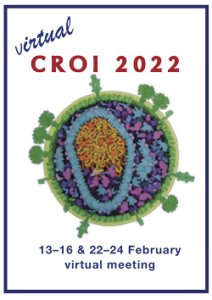CROI 2022: Fourth potential stem cell HIV cure – in a US woman using donor cord cells
1 March 2022. Related: Conference reports, Cure-related research, CROI 29 (Retrovirus) 2022.
 In a session today on HIV cure research, Yvonne Bryson and colleagues from the IMPAACT research network presented important news about another potential example of an HIV cure achieved by stem cell transplantation. [1]
In a session today on HIV cure research, Yvonne Bryson and colleagues from the IMPAACT research network presented important news about another potential example of an HIV cure achieved by stem cell transplantation. [1]
The case involves a woman living with HIV who was diagnosed with acute myelogenous leukemia (AML), a life-threatening cancer, in 2017. The researchers sourced cord blood stem cells from a donor homozygous for the CCR5 delta-32 mutation that prevents expression of the CCR5 co-receptor that most HIV strains use as an entryway into cells.
The aim was to treat the cancer while also generating a new immune system made up of HIV-resistant cells, following the model that has produced three other known cases of likely HIV cures in men (Timothy Ray Brown, Adam Castillejo and the Düsseldorf patient).
A difference with prior cases is that stem cells from umbilical cord blood are less efficient at generating a new immune system after transplantation, so the woman also received stem cells from the peripheral blood of an adult relative who lacked the CCR5 delta-32 mutation. Shortly after the transplant, most of the immune cells that could be detected were derived from the adult blood stem cells, but over time the proportion of cells derived from the cord blood transplant increased.
From day 100 of follow-up, all T cells and myeloid cells (monocyte/macrophages) were progeny of the cord blood transplant and therefore possessed the CCR5-delta32 mutation. As reported at the Annual Meeting of the American Society for Hematology in 2018, remission of AML was achieved and the woman initially continued on antiretroviral therapy (ART) with HIV viral load remaining suppressed. [2]
At CROI today, Yvonne Bryson reported that ART was interrupted three years after the transplant with no HIV viral load rebound. The woman, who’s described as middle aged and of mixed race, has now been off ART for more than 14 months with persistently undetectable HIV viral load (during this time they’ve received COVID-19 vaccination without any untoward effect).
The case bolsters the evidence that an HIV cure is achievable and demonstrates that, for people with HIV and certain life-threatening cancers, stem cell transplantation from donors homozygous for the CCR5 delta-32 mutation can work in women as well as men.
Bryson pointed out that cord blood stem cell banks can be tested for the presence of the CCR5Δ32 mutation, and the approach used in this case could increase the chances of identifying CCR5-negative donors for people with HIV who require stem cell transplants for cancers (cord blood stem cells have less stringent requirements for matching the genetics of recipients).
Background on the use of cord blood stem cell transplants in HIV cure research and the possibilities of identifying matches for people of different races can be found in an overview article published in 2015 by Lawrence Petz and colleagues. For both adults and children, the chance of successful matches are significantly reduced for African, Hispanic and Chinese Americans. [3]
comment
Although this woman also had to undergo chemotherapy and whole body irradiation, this new case has significant differences to some of the stem cell procedures used by the Berlin, London and Dusseldorf cure cases.
This included a suggestion that the use of cord cells could have been the reason that graft-vs-host disease was not experienced in this case.
However, an earlier paediatric case using cord blood cells was unfortunately not successful when the 12 year old boy died from graft-vs-host disease. The cases are not easy to compare though because of both age and more advanced ill health. [4]
It is significant that this case was a women, and also from a mixed race background where matching donors becomes significantly more difficult.
The use of cord stem cells was also reported to reduce the stringency needed with adult donors, although fewer cells available needed to an adult relative donor to contribute to the overall transplant.
The caution in referring to this case as remission is because the previous three cases needed longer follow-up before researchers felt confident to refer to a cure.
For some reason, many media reports, including the New York Times and Washington Post, seem to have forgotten the Düsseldorf patient, reported along with the London patient at CROI 2019. [5]
Source
Jefferys R. CROI 2022 Update: A new potential HIV cure case; broadly neutralizing antibody enhances post-treatment control. TAG basic Science Blog. (15 February 2022)
https://tagbasicscienceproject.typepad.com/tags_basic_science_vaccin/2022/02/croi-2022-update-a-new-potential-hiv-cure-case-broadly-neutralizing-antibody-enhances-post-treatment.html
References
- Bryson Y et al. HIV-1 remission with CCR5∆32∆32 haplo-cord transplant in a US woman: IMPAACT P1107. CROI 2022, 12–16 and 22–24 February, virtual meeting. Oral abstract 65.
https://www.croiconference.org/abstract/hiv-1-remission-with-ccr53232-haplo-cord-transplant-in-a-us-woman-impaact-p1107/ (abstract and webcast) - Hsu J et al. CCR5 delta32 cord & haploidentical grafts: allogeneic stem cell transplant for HIV+ /AML patient: a case report from the IMPAACT P1107 observational study. Blood 2018; 132 (Supplement 1): 2184. doi: 10.1182/blood-2018-99-117734
https://doi.org/10.1182/blood-2018-99-117734 - Petz LD et al. Progress toward curing HIV infection with hematopoietic cell transplantation. Stem Cells Cloning. 2015;8:109-116. DOI: 10.2147/SCCAA.S56050.
https://www.dovepress.com/progress-toward-curing-hiv-infection-with-hematopoietic-cell-transplan-peer-reviewed-fulltext-article-SCCAA - Rothenberger M et al. Transplantation of CCR5∆32 homozygous umbilical cord blood in a child with acute lymphoblastic leukemia and perinatally acquired HIV infection, Open Forum Infectious Diseases 5(5) ofy090, DOI: 10.1093/ofid/ofy090. (May 2018).
https://academic.oup.com/ofid/article/5/5/ofy090/5001531 - UK patient likely to be the second person cured of HIV: two further cases at CROI 2019 of HIV remission after allogenic stem cell transplants/ (HTB March 2019).
https://i-base.info/htb/35767
This report was first published on 15 February 2022.

